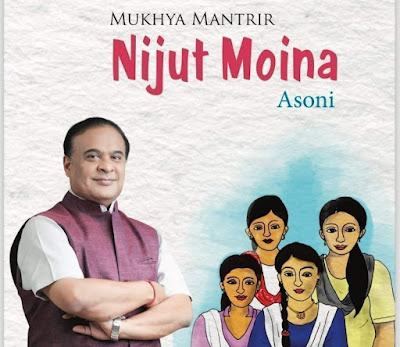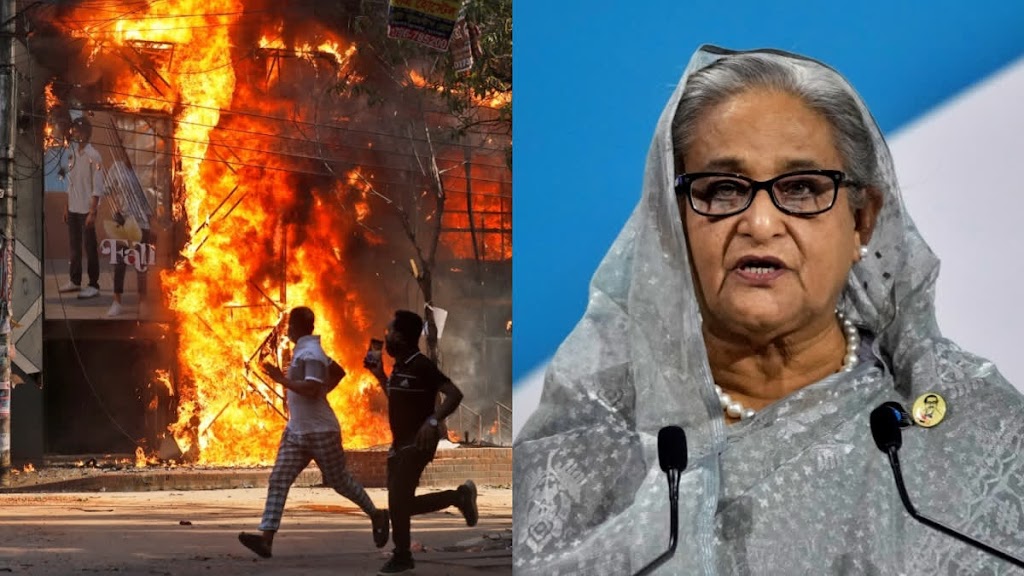Assam History GK for DHS exam 2022 | General Knowledge MCQ Questions on Assam for Grade III & Grade IV Exam Set 1
Hello, aspirants are you preparing for APSC or any other Assam Govt Exams 2022? If yes, then you must be aware of the most important Assam GK MCQ & Assam History Notes for the upcoming competitive exam preparation. Therefore every aspirants need to know the Assam History Notes for APSC Prelims & Mains Exam. In this regard “World_Polity” decides to provide you the most important 200+ Assam History GK One Liner for the upcoming exams like Assam Direct Recruitment 2022 Grade III and Grade IV Exam, DHS, Assam Police, Irrigation, PNRD, JAA exam. Infact the History Notes of Assam Questions and Answers for Assam Direct Recruitment 2022 Exam (Assam GK Quiz) will be a key topic in the Assam GK History section for the upcoming exams. So the Assam History Notes for APSC Prelims & Mains Exam will be a pedestrian to crack your exam.
Assam History Quiz – অসমৰ বুৰঞ্জী কুইজ
Assam History GK Questions for Assam Public Service Commission
In this article we have provided you Assam History GK Questions for Assam Public Service Commission. So, read all these important Assam GK for APSC Prelims 2022 for the as well as other Assam govt exams. These History Notes of Assam Questions and Answers are extremely important and should be a part of your preparation.
Best History Notes For Assam Govt Exams
In order to succeed in the prestigious competitive examination, it is important that the aspirant has access to the Best General Knowledge Questions of Assam. Specially the toppers of Assam Govt Exams recommend that candidates start their preparation with the best Assam History Notes for upcoming APSC Prelims Exam.
Assam History GK for DHS exam 2022 | General Knowledge MCQ Questions on Assam for Grade III & Grade IV Exam
There are mainly five very important Assam GK on Assam History GK for DHS exam 2022. Mark this general knowledge mcq questions on assam for Grade III & Grade IV Exam :
1. The political condition of Assam has changed with the downfall of Pala dynasty and the continuous invasion of Turko-Afgan of 12 century A.D. The capital of Kamrupa has transferred from Kamrup to Kamatapur of Kochbihar in the middle of the 13 century and then north east Bengal became the political centre of the state. Several independent or semi independent chiefs, Feudal lord, Bhuyans rose in the adjoining areas of Nogaon, Morigaon, Lakhimpur, Darrang, Sonitpur and Kamrup distrcts. At the same time, the Bodos had established independent kingdom in the area between the Dikhou and Kapili in the northern bank Brahamaputra. Again the Morans and Barahis had established their own statein upper Assam. The Ahoms initially established a tiny state in between the Buridihing and Dikhou river. The Chutiyas had created an independent state centering today’s Sadiya and some parts of north Lakhimpur Dhemaji, Dibrugarh, and Tinchukia district. Therefore in between 13 and 16 century, there were some parallel state in Assam sych as Kamata Rajya, Barabhuyans, Kachari, Ahom and Chutiyas.
2. Sukapha ,the founder of Ahom Kingdom in Assam. Ahoms was a Tai-Mongoloid group who migrated to Assam from around present-day Yunan Province of China. Siu -ka -pha was the first Ahom king in Assam. The Ahoms were given stiff resistance by the Kacharis who dominated eastern Assam. But slowly and steadily, through a policy of conciliation and assimilation and military might, the Ahoms consolidated and expanded their position in the Brahmaputra valley. Sukapha was the third son of Phu-Chang-Khang alias Chao Changnyeu,a scion of Mong-Ri mong-Ram line of kings of Khun-Long’s family. He along with about 9000 followers, 300 horses fitted with saddles and bridles and two elephants followed a known route from Yunnan to Assam that passed through Myitkyina, Mogaung and the upper Irrawaddy river valley and crossed the Patkai hills. On his way he stopped at various places and crossed the Khamjang River to reach the Nangyang Lake where he fought and defeated the Nagas and reached the Brahmaputra valley in the early 13th century.
• Download Assam Direct Recruitment Exam 2023-24 E-Book Pdf : :
Well from the below link you can download the best guide book for Asssm Direct Recruitment Exam 2023-24 ::
• Must visit : Chutiya Kingdom of Assam
• Must visit : Solved Question Paper of DHS Exam
Assam History Notes for APSC Prelims & Mains | History Notes of Assam Questions and Answers
Here are the most important best Assam History Notes for APSC Prelims & Mains Exam. Also check all these important History Notes of Assam Questions and Answers for Assam Direct Recruitment 2022 in order to answer the questions :
Assam History – অসমৰ বুৰঞ্জী
Assam was ruled by various dynasties—the Pala, Koch, Kachari, and Chutiya—and there was constant warfare among the princes until the coming of the Ahom people in the 13th century. The Ahom crossed the Patkai Range from Myanmar (Burma) and conquered the local chieftains of the upper Assam plain. In the 15th century the Ahom, who gave their name to the region, were the dominant power in upper Assam. Two centuries later they defeated the Koch, Kachari, and other local rulers to gain control of lower Assam up to Goalpara. Ahom power and prosperity reached a zenith during the rule of King Rudra Singh (reigned 1696–1714), before the kingdom was occupied by warriors from Myanmar in the late 18th century. Here we have devided the history of Assam into three period.
1. ANCIENT HISTORY (350 – 1206 or 4th century to 12th century)
2. MEDIEVAL HISTORY (1206 – 1826)
3. COLONIAL PERIOD (1826 – 1947)
Let’s take a look at the Assam History One Liner Questions –
ANCIENT HISTORY (350 – 1206 or 4th century to 12th century) –
The historical account of Assam begins with Varman Dynasty.
Varman Dynasty was established by Pushyavarman in 4th century in Kamrup.
It extends from the Karatoya in the west to Sadiya in the east.
Varman Dynasty reached its height during Bhaskarvarman’s rule in the 7th century.
During Bhaskarvarman’s rule Chinese traveller Xuanzang visited his court and wrote a significant count of Assam.
After Bhaskarvarman’s death the control of the dynasty went to Salastambha and he established a new dynasty called Mlecha Dynasty.
The Mlecha Dynasty ruled Kamrupa from 650 – 900.
Their capital was at Hadapeshvar (Tezpur).
In the 9th century, their downfall started and a new ruler came up. Their ruler was elected like the Palas of Bengal.
But the Palas of Bengal were Buddhists, the Palas of Kamrup were Hindu.
Their capitals were Hadapeshvar (Tezpur), Durjaya (North-Guwahati), Kmarupnagara (Guwahati).
Their kings were Ratna Pal, Indra Pala, Gopala, Harsha Pala, Dharmapala, Jayapala.
Pala kingdom came to an end when Kamrupa was invaded by Gaur King Ramapal (Bengal) (1072-1126).
The work of Pala Dynasty is reflected in Madan Kamdev Sculpture.
After this kingdom, the Ancient History of Assam declined and new history period began.
MEDIEVAL HISTORY (1206 – 1826) –
In the 13th century, Sandhya, a Kamrupanagar king moved his capital to Kamatapur as the Turks of Bengal were attacking and he established Kamata Kingdom.
The last kings of the Kamata Kingdom were removed by Alauddin Hussain Shah (Sultan of Bengal) in 1498.
Although Shah started ruling but they could not establish a kingdom because of Bhuyan Chieftains.
Bhuyan Chieftians were local warrior or landlords of Assam who protected the land.
In the beginning of the 16th century, Biswa Singha (Koch Tribe) established the Koch Dynasty in Kamata Kingdom.
During the period of Nara Narayan and Bir Chilari, sons of Biswa Singha this dynasty reached its height.
Similarly, in eastern part, the Kachari and the Chutiya kingdom arouse with some Bhuyan Chieftains.
Birpal was the founder of Chutia Kingdom and he formed his first kingdom in Swarnagiri (Swansiri River) in 1187.
Ratradhaajpal, son of Birpal later shifted the capital of Ratnapur (Majuli) and absorbed the Pala Dynasty and finally moved to Sadiya in 1248.
The founder of Kachari kingdom is not known.
They are also known as Dimasa Kingdom.
In this period only a Shan Group from China entered Assam and they established Ahom Kingdom.
The 16th century was very crucial for Assam as the Ahom defeated the indigenous groups of Assam Chutia Kingdom, Kachari Kingdom.
It was also the period of growth of Eksarana Dharma of Srimanta Sankardeva.
During this period, the Koch king Nara Narayan died and the Kamata Kingdom was divided into two parts – Koch Bihar (West) and Koch Hajo (East).
There started the conflict between the groups which resulted in the entry of Mughals and extension of Ahom Kingdom.
The 17th century was important for the conflict between Ahom-Mughal and the most important Battle of Saraighat took place in 1671 which finally ended in 1682 defeating the Mughals at Itakhuli in Guwahati.
Ahom Kingdom was led by Lachit Borphukan at Brahmaputra River, Saraighat.
Ahom Army was weaker than Mughal’s but with brilliant tactics they won the battle.
Battle of Itakhuli was fought in 1682 between Ahom and Mughals.
In this battle of Ahom pushed back then Mughal to the west of the Manas River.
The main battle was fought between Mughal Fauzdar Mansur Khan and the Ahom Commander Dihingia Alun Borborua and the Mughals were defeated.
With this Ahom recovered Sarkar Kamrup from Mughals.
In 18th century Ahom Kingdom lost its power under the hands of Moamoria Rebellion.
The Moamoria Rebellion (1769-1805) was the 18th century conflict between Ahom and the Motok (Chutia and Moran)
The Ahom kingdom was entering a crisis as the Paik system on which the state was based unable to adapt to the changing economy and emerging social classes.
The rise of the Sattras was one of the reasons for the leakage for manpower from the Paik system.
Under the Paik system, adult and male between 16-50 years of age were obliged to render services to the state and forms its militia and in return they received a piece of land for cultivation.
So there arose conflicts between the Ahom and those who were building sattras and the Moamoria Rebellion took place.
The rebellion started during the days of Swargadeo Lakshmi Singha and ended during the reign of Kamaleshwar Singha.
The Ahom king failed to retake the entire kingdom, the Paik system was abolished and the economy was totally destroyed.
The weakened Ahom kingdom fell to a Burmese Invasion which ultimately led to colonization.
With defeat of the Burmese in the first Anglo-Burmese war and the subsequent Treaty of Yandaboo, control of Assam passed into the hands of the british.
The Treaty of Yandaboo was a peace treaty that ended the first Anglo-British war.
It was signed on 24th February 1826, nearly after the war was broken out on 1824 between British and Burmese.
The Burmese accepted the British terms to without discussion and they agreed on British Interference on Assam.
COLONIAL PERIOD (1826 – 1947) –
The colonial Assam started with the Treaty of Yandaboo between the British and Burmese.
By this treaty the Burmese were expelled from Assam by the British after the Anglo-Burmese war, 1824.
After that the Assam Valley came into the hands of the British and the period of Colonization started.
The British annexed all the local group of Kings of Ahom, Chutia, Kachari, etc.
They include Assam under Bengal Province.
The plantation of tea also started in this period.
The British brought some Chinese labour to grow tea and also Chinese plant of tea, they mixed both Assam and Chinese tea and found it successful to grow in Assam.
They established a company ASSAM TEA COMPANY in 1839.
They also brought labours from central India and treated them as slaves. The British started ruling everywhere in the state and the people of Assam started to protest against the British.
The first person who came against the British was GOMDHAR KUNWAR, but he suppressed by the British.
Later on, some other people arose against the British- Dhananjay Burhagohain, Piyali Phukan, Jiuram Medhi.
But these people were sentenced to death in 1830.
In 1857 people of Assam also took part in the Indian rebellion.
Maniram Dewan and Piyali Baruah were the leaders of this rebellion in Assam, but they were arrested.
Again in 1861 – the peasants of Nagaon were violently suppressed at Phulaguri Ghat, because they protested against the tax on beetel-nut and paan.
Again in 1874, Assam was separated from Bengal province and Sylhet was included in Assam under Chief Commissioner’s Province.
The capital of Assam was made at Shillong.
The official language was changed to Bengali from Assamese.
Meanwhile, oil was discovered in Digboi and apparently the OIL Refineries grew up.
In 1903 – Assam Association was formed and Manik Chandra Baruah was the first secretary.
In 1905, Bengal was partitioned and East Bengal was added to Chief Commissioner’s province.
It led to the migration of people from Bengal to Assam and they started to settle in the riverine tracts (Char) of Brahmaputra Valley.
These people were encouraged to grow different variety of crops by the British.
Between 1905 and 1921, many people migrated to Assam Valley which continued later on and give rise to Assam Agitation of 1979.
In 1912, Assam legislative council was made with 25 members.
Later on, it was transformed to Assam Pradesh Congress Committee in 1920-21.
Under Government of India Act, 1919 its members were increased to 53 and in under Government of India Act, 1935, the council expanded the members into 108.
Gopinath Bordoloi and Muhammad Saadulah rose at this period.
Must visit : Assam History MCQ Set 16
Must visit : Assam History MCQ Set 17
Must visit : Assam History MCQ Set 18
Must visit : Assam History MCQ Set 19
Must visit : Assam History MCQ Set 20
Assam History Questions and Answers 2022 (Assam GK Quiz)
We hope that the given Assam History Notes for upcoming exams is very helpful and useful at the time of preparation. To get more History notes on Assam, visit our site www.worldpolity.com
• Must visit : History of Medieval Assam from Sukaphaa to Purandar Singha
• Must visit : Alternative Names of Ahom Kings
APSC, Assam Direct Recruitment 2022 Grade III and Grade IV Exam, DHS, Assam Police is considered as one of the toughest exams in Assam and is conducted with tight security. So to grab a job it’s always all about how well you have read & how much revisions you have done. Thank you. Best of Luck.
Now World_Polity is on every platform you can connect with us by just clicking the below social media links. Thank You.
• Subscribe our Youtube channel
• Join our Facebook Page
• Join our telegram Channel
You may also visit :
Well if you like this article on Assam History Notes for APSC Prelims & Mains | History Notes of Assam Questions and Answers for Assam Direct Recruitment 2022 Exam, do comment & show your support by sharing it to the other aspirants and if there is any query you are welcome to ask.




